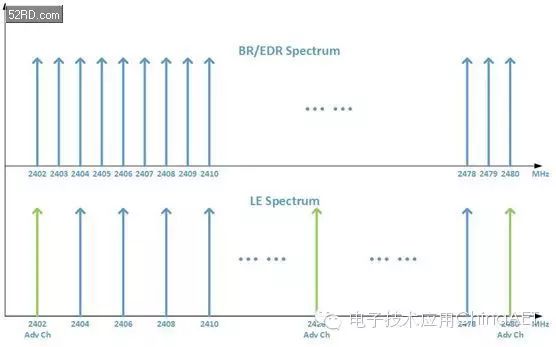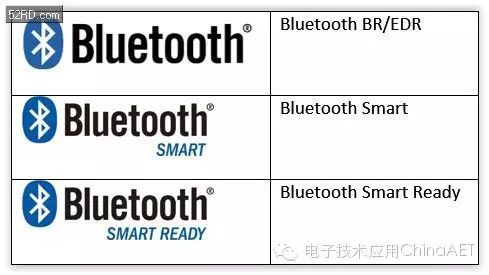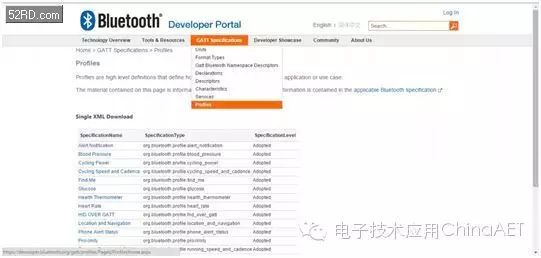Whether you are an ordinary consumer or a tech enthusiast, Bluetooth is definitely a term you are familiar with. However, if you are a Bluetooth application developer or a tech geek, it is essential to further understand the two major Bluetooth technologies in the core specifications: Bluetooth BR/EDR (Basic Rate/Enhanced Data Rate) and Bluetooth Smart. This article will comprehensively analyze the differences between these two technologies, deepening your understanding of Bluetooth technology!
Physical Channel
All radio communications occur over predefined channels, and Bluetooth is no exception. However, the channels used by Bluetooth Smart differ slightly from those of Bluetooth BR/EDR, especially with the introduction of broadcast channels in Bluetooth Smart.
BR/EDR: 79 channels, channel index from 0 to 78, covering a range of 2400 to 2483.5MHz
Bluetooth Smart: 40 channels, channel index from 0 to 39, covering a range of 2400 to 2483.5MHz, with channels 37, 38, and 39 being broadcast channels.

RF Spectrum, Bluetooth BR/EDR vs. Bluetooth Smart
Brand
The Bluetooth trademark has three types that can be used to distinguish the type of Bluetooth used in products. Manufacturers will use these trademarks on the product itself or its packaging.

The Bluetooth trademark has three types that can be used to distinguish the type of Bluetooth used in products
You may already be familiar with BR/EDR and Bluetooth Smart, but you might not know about Bluetooth Smart Ready. Bluetooth Smart Ready devices can receive data from other Bluetooth devices, and this data can be transformed into useful information by applications on Bluetooth Smart Ready devices, such as smartphones, personal computers, and tablets.
Power Consumption
Low power consumption is one of the highlights of Bluetooth Smart. Bluetooth Smart devices can run for months or even years on a single button battery. The flexible configuration of Bluetooth Smart also allows applications to better manage connection intervals to optimize the receiver’s working cycle. For Bluetooth BR/EDR, due to its higher data throughput, power consumption will correspondingly increase. For more information about power consumption, please refer to section 4.5 of Volume 6 Part 2 of the Bluetooth 4.2 Core Specification.
Topology
BR/EDR supports star network topology with a piconet and also supports distributed networks (scatternet). In a distributed network, each piconet has one master device, and slave devices can participate in different piconets based on time-division multiplexing.
Bluetooth Smart version 4.1 supports “dual mode,” allowing Bluetooth Smart devices to simultaneously play two roles: central device and peripheral device. Devices supporting the central role can initiate connections to peripheral devices, while devices also supporting the central role can act as peripherals and connect to other central devices. In the future, it will also support Bluetooth Smart Mesh, and the Bluetooth Special Interest Group Smart Mesh working group is working hard to provide prototypes for testing. Many smart home or industrial automation applications will benefit from Bluetooth Smart Mesh technology.
Development
Bluetooth Smart development is very flexible, allowing developers to customize applications more flexibly using the profiles adopted by the Bluetooth Special Interest Group. No matter what application scenario developers want to create, the flexible profile definitions can meet technical requirements. In contrast, BR/EDR technology is relatively mature, and its development is module-level, so usually, it only requires integrating the module into the product. For example, when developing a Beacon application, Bluetooth Smart should be chosen, as BR/EDR does not support Beacon applications.
Pairing
Pairing is mandatory for Bluetooth BR/EDR, while it is optional for Bluetooth Smart. Some simple Bluetooth Smart applications may not require pairing.
Throughput
The throughput of Bluetooth Smart is about 1 Mbps (according to specifications), but it also depends on the application scenario. The throughput of Bluetooth BR/EDR is greater than 2 Mbps, suitable for high-quality audio streaming or other applications requiring higher bandwidth while maintaining a connection.
4.x
People often ask if a Bluetooth headset compatible with Bluetooth 4.x means that the headset is low power. Can Bluetooth Smart be used for audio applications? Now, let me explain that one volume of the core specifications is for low-power controllers, and another volume is for Bluetooth BR/EDR controllers. Generally, if a headset supports 4.x, it is compatible with 4.x BR/EDR specifications, but not compatible with low-power specifications or Bluetooth Smart. You can confirm whether it is a Bluetooth Smart product by identifying the Bluetooth Smart trademark on the product packaging.
Profile
The Generic Attribute Profile (GATT) can be called by applications or other profiles for data interaction between clients and servers. Currently, there are many profile definitions built using GATT.

GATT on the website. Note: Changes may occur in 2016
BR/EDR profile includes: Headset Profile (HSP), Object Exchange (OBEX), Audio Streaming (A2DP), Video Streaming (VDP), and File Transfer (FTP). We look forward to more Bluetooth BR/EDR profiles migrating to Bluetooth Smart in the future.
Internet Capability
The Bluetooth Special Interest Group provides three methods for accessing the Internet based on Bluetooth Smart technology: RESTful API, HTTP Proxy Service (HPS), and Internet Protocol Support Profile (IPSP), all of which require a gateway device for connection. The gateway device can be any device that can access the Internet, such as a router, set-top box, or even an idle smartphone at home. The Internet capability of Bluetooth Smart makes the Internet of Things more reliable and easier to implement. Recently, Google released the OnHub router, which can connect Bluetooth devices to the Internet.
Finally, I hope this article helps developers understand the main differences between different Bluetooth technologies, allowing them to choose the appropriate technology for their applications more effectively.